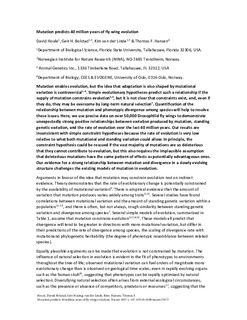Mutation predicts 40 million years of fly wing evolution
Journal article, Peer reviewed
Accepted version

View/
Date
2017Metadata
Show full item recordCollections
- Publikasjoner fra CRIStin - NINA [2397]
- Scientific publications [1423]
Abstract
Mutation enables evolution, but the idea that adaptation is also shaped by mutational variation is controversial1–4. Simple evolutionary hypotheses predict such a relationship if the supply of mutations constrains evolution5,6, but it is not clear that constraints exist, and, even if they do, they may be overcome by long-term natural selection. Quantification of the relationship between mutation and phenotypic divergence among species will help to resolve these issues. Here we use precise data on over 50,000 Drosophilid fly wings to demonstrate unexpectedly strong positive relationships between variation produced by mutation, standing genetic variation, and the rate of evolution over the last 40 million years. Our results are inconsistent with simple constraint hypotheses because the rate of evolution is very low relative to what both mutational and standing variation could allow. In principle, the constraint hypothesis could be rescued if the vast majority of mutations are so deleterious that they cannot contribute to evolution, but this also requires the implausible assumption that deleterious mutations have the same pattern of effects as potentially advantageous ones. Our evidence for a strong relationship between mutation and divergence in a slowly evolving structure challenges the existing models of mutation in evolution.